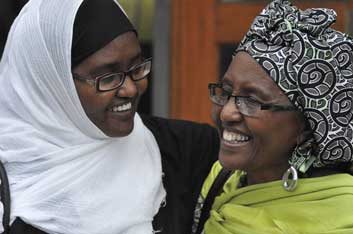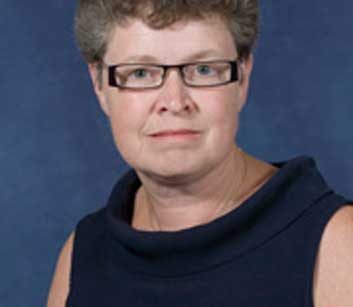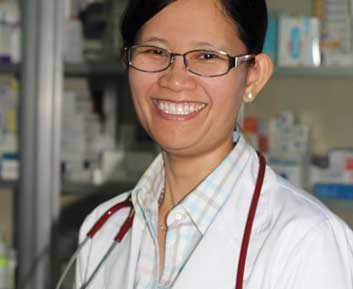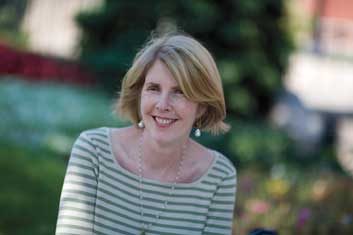
Deqo Mohamed
Deqo Mohamed estimates there are only about 200 doctors in the whole of her home country, Somalia-population of over nine million. Of those, she says, only 10 are women. Deqo, her sister Amina and their mother, Hawa Abdi, account for three of them.
In the early 1970s, after returning from her medical studies, Hawa Abdi became one of Somalia’s first female gynecologists. She opened a clinic and one of the region’s largest camps for internally displaced people, which includes a hospital. Both Amina and Deqo grew up working alongside their mother. “While in high school,” Deqo, 37, says, “I was treating deep wounds, delivering babies, working in the emergency room….I did everything except the surgeries. My mother would often scold me-‘Don’t do this, you don’t have a medical degree, you don’t know how.’ But we had no doctors, and the people really needed help.”
Deqo went on to earn her medical degree in Moscow in 2001-she specialized in obstetrics and gynecology. After working briefly in the United States, she returned to Somalia to work full-time as a doctor. Like her mother and sister, she has faced many hurdles as a female doctor in this tiny East African country, which is plagued by war, poverty, corruption and famine. In Somalia, ranked by the United Nations as one of the world’s most dangerous places, women are not encouraged to even go to school, let alone university, or to have jobs in fields such as medicine.
Deqo, Amina and their mother’s foundation, the Dr. Hawa Abdi Foundation, seeks to help Somali women dream, by providing scholarships to train female doctors and nurses, and medical training for both men and women. But it’s an uphill battle. For one thing, male doctors are not allowed to treat women, so the women usually end up being seen by nurses or, more likely, receiving no treatment at all. And so many females, particularly in rural areas, do not go to school, so there isn’t much chance they will become healthcare workers. Those who are fortunate enough to attend school and dream of becoming doctors are often married off before their university studies begin.
Each day, Deqo, her sister and their mother treat more than 250 patients. Deqo’s greatest joy is when she saves a pregnant mother or brings a new life into the world. Her sadness: “Lack of peace. The children dying every day from starvation that we could treat. And losing the mothers who cannot come to the hospital because their husbands and fathers won’t let them.”
Image: Michelle Shephard/Getstock.com

Kathryn Wood
Kathryn Wood is that rare breed: a female scientist. This British woman, who has paved a road for many to follow, is considered one of the world’s leading stem cell researchers. She says she climbed to the top of the science world “from sheer hard work and having gifted mentors.” Born in the small town of Loughborough in the U.K.’s Midlands, Wood and her only sibling, Alison, who’s also a scientist, attended an all-girls school where science was encouraged, not discouraged. “I had excellent teachers,” says Wood, 55.
That’s lucky for us, because relatively few women go into the sciences. (For example, according to Statistics Canada, women accounted for only 23 percent of enrolment in architecture and engineering university courses in 2003/ 2004.) While life sciences tend to have a higher number of female students graduating with degrees, the number of women who actually become scientists is still low. There are a number of reasons for this, including the fact that many need to take time away from their careers for child rearing.
Wood’s mother was her biggest fan. “She told my sister-who is now a pharmacologist-and me that she always wished she had continued her education,” says Wood. “As soon as she was old enough, she married my dad and had us instead.”
As a professor of immunology, transplantation and stem cell research at Oxford University, Wood’s focus has been on how stem cells can replace immune-system-suppressing drugs for transplant patients. People with transplants have to take these medications, often for the rest of their lives, Wood explains, so that their body’s immune system does not reject the new organ. As a result, they are at increased risk for other diseases, such as cancer. If stem cells can be used instead of the drugs, Wood says, patients would have less chance of contracting these other illnesses. She also collaborates on a clinical program at Oxford University researching how stem cells can help people who have diabetes.
Wood encourages other women to enter, and stay in, the field of science. She realizes how difficult it can be. “It’s really important to have a supportive environment,” she says. “And that is not always the case. But I stress that if a woman…in fact, a scientist of any gender…has the dedication and positive feedback from some of their supervisors, press on!”

Ly Srey Vyna
Ly Srey Vyna is a physician and politician in one of the poorest countries in Asia: Cambodia. Many people, particularly in rural areas, lack medical care. Fortunately, Ly, now 43, was born into a relatively well-off family, and as a little girl she started to dream of ways she could make a difference. With her high grades and aptitude in sciences and math, becoming a family doctor seemed like the logical choice. After obtaining her medical degree in Poland in 1996, she returned to Cambodia to start a family and open two family clinics. The Ly Srey Vyna Medical Group offers services to people of all classes, who are charged on a sliding scale depending on what they can afford. The female patients really trust her, for there are very few female doctors in Cambodia; in fact, when some male patients come to see her, they don’t believe she is “Dr. Srey”-they are expecting a man. “The women are at ease talking with me about their problems and their medical needs,” says Ly. “I knew when I started that I was making a difference in their lives.”
Yet almost immediately after opening her clinics, Ly saw that the biggest obstacle barring her country’s overall development was corruption. Rich or politically connected medical-school students in Cambodia can pay their professors or the university administration to give them high marks on exams, and even degrees that they didn’t earn. “There are many doctors in Cambodia who are offering really bad medical care,” says Ly. “Some are hurting more than they are helping.”
In 2008, Ly decided to change this by entering politics. She won a seat in the capital, Phnom Penh, representing the opposition Sam Rainsy Party. “I knew as a doctor I couldn’t stop the corruption,” she explains. “But I strongly believe that an honest and strong politician can lead a country to prosperity and to freedom.”
Ly was elected, but had no idea how challenging being an agent of change would be. She discovered that the news media are either owned or controlled by the ruling political party. As a member of parliament, Ly has spoken out on many issues, only to find herself attacked by the media.
However daunting, Ly, who was re-elected this past summer, has no regrets about being a politician or a doctor, especially when she sees how her own children-three sons and two daughters-have been inspired by her work. “They are all top students, have wonderful personalities, and are caring and loving,” she says. “Two of them want to be doctors. Like me, they are motivated to be good leaders, even good politicians one day, striving for freedom and prosperity in our country-for all, regardless of gender, class or political affiliation.”
Image: Rupert Winchester

Kay Jamison
Kay Jamison was 17 when she fell into a depression that descended into bipolar disorder (at the time called manic depression). But in the 1960s, few people knew much about mental illness, let alone recognized the symptoms. Despite her battles, Jamison managed to receive her Ph.D. in clinical psychology at the University of California in Los Angeles, afterwards garnering a staff position and founding the school’s Affective Disorders Clinic.
At UCLA she was eventually diagnosed with bipolar disorder, and controlled the symptoms with lithium. But Jamison didn’t always adhere to doctor’s orders. During a long stint when she thought she no longer needed meds, she attempted suicide.
Today, Jamison is a Johns Hopkins University psychologist, the first woman in the history of the institution to receive an endowed professorship in its department of psychiatry. At 66, she’s considered a world leader on bipolar disorder and suicide. The bestselling author of An Unquiet Mind and Night Falls Fast: Understanding Suicide, she’s best known for shedding a light on mental illness and helping to elevate it to public policy discussions in the U.S. The statistics, after all, are staggering. Worldwide, suicide is the seventh top killer of women age 20 to 59.
Bipolar disorder is symbolized by periods of highs or manic behaviour, followed by periods of lows. “In talking about my own story,” says Jamison, “I hope people will have an understanding of what the pain feels like. It is a very lonely illness.” Jamison believes if we can de-stigmatize mental illness, sufferers will be more inclined to seek treatment. “The science of the brain is moving fast, and most mental illnesses today can be recognized and managed.”
Image: Johns Hopkins Medicine

Jane Philpott
Jane Philpott grew up in Cambridge, Ont., the eldest in a family of four girls whose parents instilled the belief that they could do whatever they wanted. “We knew we had the potential to pursue our dreams, which is not true for everyone,” says Philpott, 51. “I had more in this world than most people, so I had a responsibility to give back.”
Philpott dreamed of becoming a doctor, and after getting her medical degree at the University of Western Ontario, decided to use it in a developing country. She moved to Niger in 1989 with her husband, Pep. For nine years she worked as a doctor and Pep worked in health administration. She saw first-hand the food shortages that led moms to bring in their malnourished kids.
Then, Philpott’s eldest daughter, Emily, died at the age of two and a half from meningococcemia, a serious illness she’d have had a better chance of surviving in a Western hospital. “It’s not a reality of life in Canada, but so many women I met in Niger had also lived through this,” says Philpott. “There, some 15 percent of children won’t live to age five; when I was there in the early ’90s, it was even worse: 25 percent. I wanted to do more.”
Philpott, Pep and their remaining children returned to Canada in 1998. In 2004, she gave a talk on HIV/AIDS at the Markham-Stouffville Hospital north of Toronto, where she now heads the department of family medicine, and suggested to the audience that they give a day’s salary to an organization like the Stephen Lewis Foundation. She never anticipated this would start a movement, but since that day, staff at the hospital have raised more than $3 million for various charitable organizations.
The idea is simple: Each year, a person donates one day’s salary (or more if they like) directly to the charity of their choice. Philpott’s Give a Day non-profit initiative offers encouragement and ideas on where best to give, depending on the donor’s interests. At first, those in the medical profession were the biggest supporters, but today, lawyers contribute more per year than any other group.
Philpott is involved in other development projects, including a post-graduate program for family medical practitioners between the University of Toronto and Addis Ababa University. “In Ethiopia, there’s one doctor for 40,000 people. In Canada, it’s one for every 450.” The aim is to train more Ethiopian doctors to work there.
“One person can only do so much,” she says. “Collectively, we can accomplish so much more. I’d like to do as much as I can to make the world a fairer and healthier place.”
Related:
• What it’s like to be a nurse these days
• Canada’s best medical care for women
• Why Canadian health care is better
